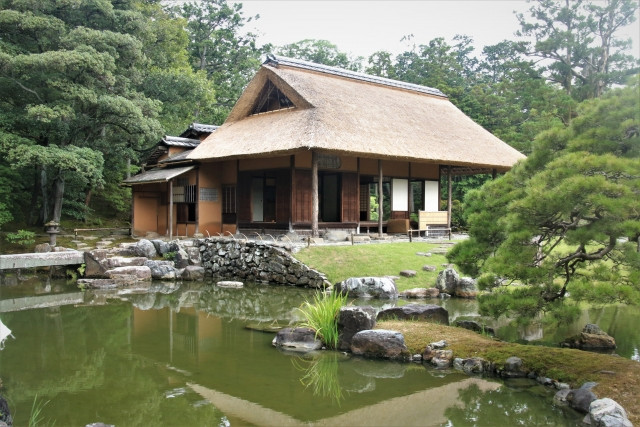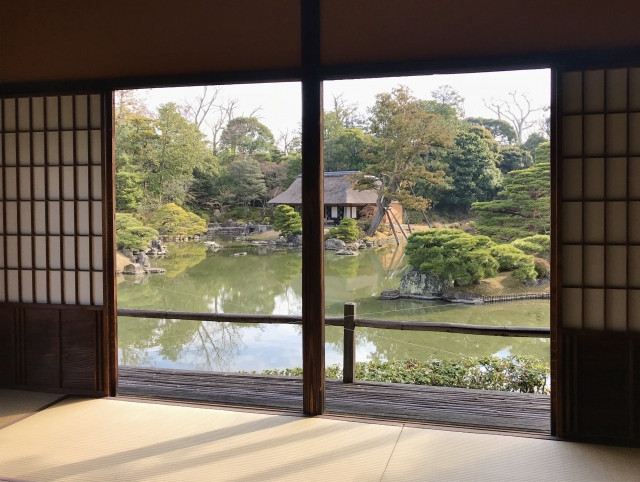Katsura Imperial Villa has great historical and cultural importance, as it showcases traditional Japanese architectural design, not only in the structure but in the surrounding garden as well. The beautiful residence is a little out of the way from the popular locations in Kyoto but well worth the well-planned visit.
Table of Contents
- The Basics of Katsura Imperial Villa
- What to Expect in Katsura Imperial Palace
- Important Information About and Access to Katsura Imperial Villa
- Takeaway
The Basics of Katsura Imperial Villa

Japan has preserved many buildings from its history to celebrate what they represented at the time and to be a reminder of the country’s long and rich culture and history. One such architectural piece is 桂離宮 (Katsura Rikyu) or Katsura Imperial Villa, a breathtaking imperial residence situated on Katsura River’s western bank. It is also known as Katsura Detached Palace, so the words villa and palace may be used interchangeably throughout this article.
Katsura Imperial Villa is spread across roughly 70,000 square meters and is popularly known for its beautiful garden and traditional Japanese design. If you take a walk around the garden, you can see many picturesque landscapes with trees and hills, ponds and small bridges, gates, etc. with much to explore in the large area.
The palace was the home of the Hachijo-no-Miya family, constructed between the early to mid 17th century. Prince Toshihito, who was in charge of building the palace, was inspired by the location and party in The Tale of Genji. At the time, the villa was used mainly for tea ceremonies and 月見 (tsukimi or moon-viewing). Katsura Rikyu is now being managed by a government authority, the Imperial Household Agency and can only be entered through reservation.
Writer's Pick
What to Expect in Katsura Imperial Palace
Some of the things you can expect from this cultural treasure include:
Beautiful Structures

There are three main structures in the Katsura Imperial Villa built in the traditional shoin (studies or halls) style:
- the ko-shoin (old)
- chu-shoin (middle)
- shin-shoin (new)
The defining feature of these buildings are their large, open spaces with tatami floors, wooden verandas, and traditional sliding doors called shoji. Unfortunately, these buildings cannot be entered, but you can see into them from the walkway. As mentioned earlier, the prince who built the residence was inspired by The Tale of Genji and wanted to make sure that his palace would have the perfect moon-viewing rooms and even a moon-viewing platform that extends out to the pond to reflect the events in the story.
An Emphasis on Tea Ceremonies

Besides moon-viewing, the palace was also built to accommodate tea-ceremonies. How can you tell? Well, the palace has four separate teahouses (initially there were five) that are designed for each season. The four teahouses are Shokin-tei, Geppa-ro, Shoi-ken and Shoka-tei. The purpose of the tea ceremony is to find inner peace not only by drinking the tea but through the process of making the tea as well as using special tools and utensils. The four structures provide spaces to do so, but by each having a different view of the garden, they are intended to invoke different feelings to those partaking in the ceremonies.
The Garden

Like stated earlier, not only are the structures impressive at Katsura Imperial Villa, but so is the 庭園 (teien) or the garden. You will find meticulously placed rocks, paths, trees and ponds to further enhance the palace as a whole. The tranquil environment is perfect for meditating on the reflection of the rocks, trees and buildings in the pond. There’s even a section inspired by what is called one of the three scenic beauties in Japan - Amano Hashidate. So the palace grounds not only are a beauty on its own but also incorporate elements from other locations in Japan as well. And by visiting in different seasons, you can see how the seasonal elements create a special environment worth visiting multiple times.
To read more about Japanese gardens, check out our article:
The Captivating Gardens of Japan
Important Information About and Access to Katsura Imperial Villa

Access
You can reach Katsura Rikyu via train and bus. It is a 20-minute walk from Katsura Station on the Hankyu Kyoto Line if you choose to walk. You can also take the city bus or Keihan Kyotokotsu bus and get off at the Katsura Rikyu-mae Stop. It’s about a 15-minute walk to the palace from the bus stop.
Please note that Katsura Imperial Villa is in a residential area - it is not full of touristy things to do like other areas of Kyoto. In fact, there is hardly anything else for tourists to do in the area. So plan your visit accordingly during the day so you can fill it up with other things to do.
Important to know
-
You MUST make a reservation in advance to visit. You can do so at the official website.
-
All visits are done via guided tour. There are no exceptions so you must stay with the group in the time slot you are assigned. The tour is one hour long.
-
The tour fee is 1000 yen for adults, free for those between 12 and 17. Children under 12 years old are not allowed into the venue.
-
There are tours in Japanese and English, so sign up accordingly.
-
If you are unable to get a reservation prior to your trip, they do allow same-day appointments. However, you must go early and sign up in advance for a slot. There are limited slots available for each tour. These slots are for guided tours only in Japanese, but there are free audio guides available in English.
-
Foreign nationals must show their passports at the time of booking the appointment so make sure you bring yours.
-
You are not allowed to take pictures everywhere in Katsura Imperial Villa so please respect the rules and only take photographs at the designated spots.
Takeaway

If learning about and seeing historical establishments entices you, then visiting Katsura Imperial Villa should be on your list while visiting Japan. It has been hailed as an architectural and cultural masterpiece by Japanese and foreign nationals alike for centuries. Make sure to book your appointment to experience it for yourself.



















.jpg)











